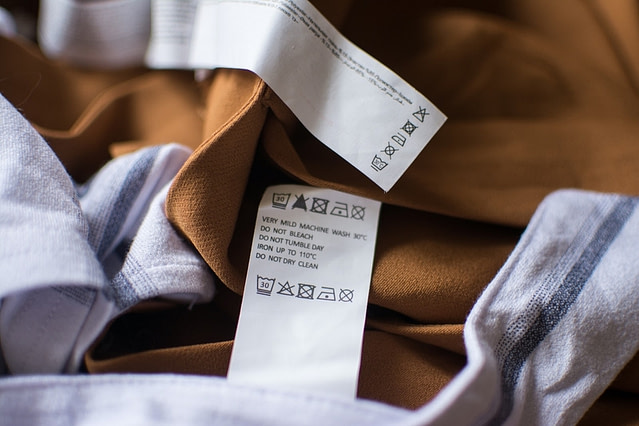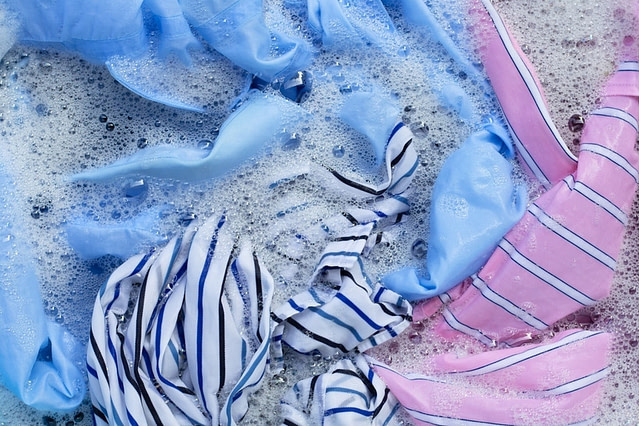A Guide on How to Wash Colored Clothes
7 minute read

From bright blue to royal red, colorful clothes can be a great way to display your personality, whether you’re headed to work or out for a night on the town. Of course, with all that wear comes washing, and knowing how to wash colored clothes is just as important as knowing how to wash white clothes.
But what is the right way to wash colored clothing? First, you’ll definitely want to use an sustainable laundry detergent like our ECOS Plastic-Free Laundry Sheets to help reduce plastic. But if you want to keep your darks dark and your brights bright, you also have to learn how to separate laundry.
Let’s go through the laundry basics like sorting, washing, and drying – so that the next time your hamper is full, you’ll have no worries.
Step 1: Check the Tag
Hello, it’s your laundry speaking. Okay, not really—but if your laundry could talk, it’d probably tell you to read the tag. That tiny square tickling the back of your neck is the ultimate built-in user guide to clothing care.
Yep—those little printed tags can give you intel on everything from water temps to spin cycles and even tell you how to wash colored clothes. Still, they can require some translation. Common laundry tags include:
- Hand wash only – The agitation that a typical washing machine uses to clean your laundry can lead to fraying and tearing of clothing labeled “hand wash only,” like your delicates for example. In the case of this tag, we recommend filling up a basin of water, applying a little detergent, and gently scrubbing until everything feels clean.
- Dry clean only – For some fabrics, any amount of water is too much. Enter dry cleaning – a chemical process that uses solvents instead of water to clean clothing. We suggest keeping clothing with this tag far from your regular laundry. Find a local dry cleaning service (bonus points if it’s environmentally friendly) with great reviews and leave this type of washing to the professionals.
- Machine wash – Consider this tag a green light. Any clothes with this tag attached should do well in the washer—provided you follow the below steps.

We also like to check the tag for clues to our clothing’s materials (cotton, polyester, etc.). It may even suggest the best washing temperature for the garment. The manufacturer typically knows best about proper laundering and care, so always take their advice first. For most clothing, cold water and a detergent designed to clean well in cold water, like ECOS, is your best bet.
Step 2: Separate
When it comes to washing colored clothing, you have to pair clothes with similar color hues. We promise your washer won’t judge you for your lack of contrast. In practice, this often requires you to separate your clothes into multiple piles of laundry. Does that mean a different wash for every color of the rainbow? Not at all. The key is to set apart your lights and darks.
Light clothing:
- Yellows
- Tans
- Off-whites
- Pastels
- Light blues
- Light greens
- Pinks
Dark clothing:
- Blacks
- Reds
- Navy blues
- Dark grays
- Browns
- Dark greens
Of course, sometimes things get complicated. If you find yourself holding up a multicolored striped shirt or paisley-patterned blouse and wondering if it’s light or dark, our advice is to take a long look at your garment, decide what its primary color is, and match it the best you can.
It also won’t be the end of the world if a dark blue and a light blue are occasionally washed together, but over time, it could lead to the dulling of both colors through a process known as “transference.” Transference occurs when some of the dyes from the darker clothing transfer to the lighter clothing.
Distinguishing your laundry by color isn’t the only way you’ll need to prepare for a perfect load. You’ll also want to separate your dirty clothes by texture or material type. That can mean grouping items such as:
- Delicates – For the garments that seem strong enough to handle a wash but are still on the fragile side of fabrics, there’s the delicate cycle option on most washing machines. This option uses light agitation and mild temperatures to ensure these garments keep their color and shape.
- Towels – Thick, absorbent, and heavier than the average t-shirt or blouse, colored towels typically get their own particular time in the washer.
If all the separation leaves you with too many loads of laundry, simply save up the smaller piles until you have enough for a full load. And luckily, for all of these separated loads, you can use ECOS laundry detergent. We’ve formulated it to work for lights, darks, delicates, and heavies so you can ensure each load is getting the best wash.
Step 3: Bag It
You may picture the washing machine as the spinning teacup ride of your clothes’ life, but unlike you at the county fair, there’s no seatbelt in your washing machine to keep your clothes from getting roughed up. Your best bet to prevent any extra wear and tear is to bag your clothes. Mesh laundry bags are nothing new, but experienced launderers know how much these bags can help.
Here are some of the mesh laundry bag benefits that can keep your laundry coming out fresh, clean, and practically as good as new:
- Tear protection – Zippers, straps, and buttons collide within the washing machine. Any unlucky spin cycle can lead to holes and tears and the untimely retirement of some of your favorite looks. With a mesh laundry bag, you can keep clothes protected while ensuring they get a great wash.
- No lost items – We’ve all had the experience of folding clothes, only to find a sock without a match or a missing accessory. By sealing smaller items in a mesh laundry bag, you help to eliminate the possibility of losing a piece of clothing along the way. That means no more orphaned socks.
A laundry bag can be a big boost for the quality of your laundry and for the environment overall. These bags actually catch microfibers from your washer so that you can toss them in the trash once the cycle is done. Plus, it makes separation simple and speeds up the process of folding and putting away your clean clothes.
Step 4: Wash Cycle
You’ve made it to the machine. With your clothes examined, separated, and bagged, the next step is to finally get them clean.
Once you’re ready to do your first load of colored clothes, keep the following advice in mind:
- Minimal water – Most washers allow you to choose the amount of water for each load, and a little goes a long way. Plus, using less water means your detergent is less diluted, allowing it to be even more effective (and your wash even more sustainable). The truth is, as long as everything gets an adequate amount of water and detergent, it should come out perfectly clean.
- Keep it cold – Cold water is the key to keeping things from going grayscale. Too high a temperature will lead to more transference and cause colors to fade faster. Keep things at a low temp to preserve your colors for many washes to come. Not to mention, cold washes are better for the environment and eliminate most of the energy used to heat the water for your wash cycle.
- Stain removal and special treatment – Whether you’re trying to figure out how to remove yesterday’s coffee stain, a spot of pizza sauce, or even how to get oil stains out of clothes from that amazing aglio e olio pasta you just enjoyed, there are specialized treatments to help you keep your colors spot-free. Consider using a plant-powered spray-on stain fighter or multi-purpose stain remover to improve discolorations and bring some clothes back to their original colors.

Step 5: Drying Options
Once your clothes are washed, sparkling clean, and smelling oh-so-fresh, you still have one more step before you can fold and wear. We’re referring, of course, to drying them.
The drying process is essential to returning your now-beautifully washed clothes to their original crisp colors and soft fabrics. There are a few options where that’s concerned, including:
- Line dry – String up a clothesline in your backyard, basement, bedroom—wherever you have space. Outside is preferable if the weather’s warm, but so long as you have a dry, ventilated area, there’s no reason you can’t line dry your clothes indoors. This method can take less than an hour or several hours depending on the climate, but it’s the most gentle way to dry clothes. The best part? It uses significantly less energy, which is better for both the planet and your wallet.
- Machine dry – Most modern dryers are designed to spin, heat, and fluff your clothes to dry, crisp perfection. While the process of machine drying can be a little harsh on colored laundry, most garments are designed for machine dryers and can hold up after dozens if not hundreds of dryer cycles. Remember to dry your clothes on low heat, as this not only uses less energy, but will also preserve the color of your clothes long-term.
Before putting a new piece of clothing in the dryer, double-check the tag to ensure the manufacturers haven’t printed any warnings about machine drying or sunlight sensitivity.
Chemicals to Avoid for Brighter Colors (and a Brighter World)
One thing’s for sure—there are chemicals in conventional laundry detergents that can do a lot more harm than good, negatively impacting your health and the environment.
You can do yourself, your clothes, and the world some favors by avoiding the following:
- Optical brighteners – These chemicals may claim to make your colored clothes even more radiant than before, but they actually work through the use of pollutants that coat your clothes with “fluorescence” that only sits on the surface. These chemicals are bad for the environment and can even irritate your skin.
- Chlorine bleach – You probably already know that you should keep bleach far away from any colored fabrics, or else risk those dreaded colorless spots and streaks. But this chemical can damage more than clothing – like your lungs, your skin and eyes, and our natural ecosystems. Opt for our safer bleach-alternative, ECOS OxoBrite Multi-Purpose Stain Remover, instead.
- Dyes – These colorful chemicals are added to most laundry detergents and have no benefit other than to make your detergent appear a different color. These dyes contain harmful chemicals that can be carcinogenic and have even been linked to certain mood disorders and hyperactivity.
To ensure you’re using safer products, you can always look out for the Safer Choice logo. ECOS has more than 150 Safer Choice products available. This certification means that the products are not only better for you and the environment, but they perform just as well as other traditional cleaning products.

Brighten Up Your Laundry Day With ECOS
Laundry isn’t necessarily the most exciting part of anyone’s day, but this regular chore can feel familiar, simple, and stress-free by following this step-by-step guide. If you’re looking for one more way to make laundry day even better, be sure to check out our full line of ECOS plant-powered cleaning products.
